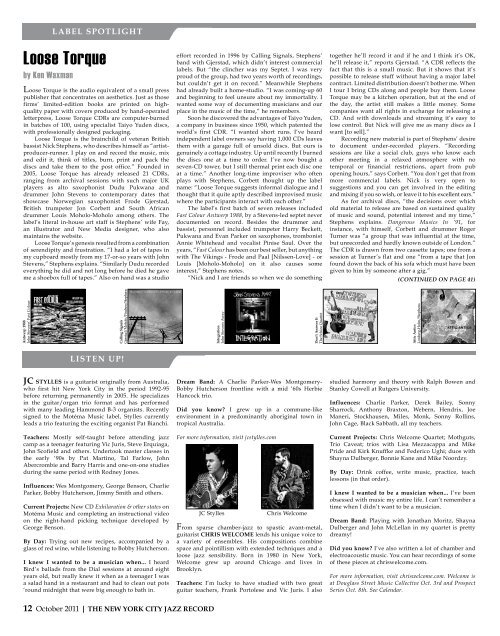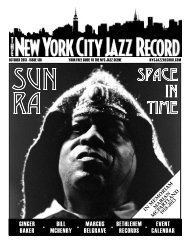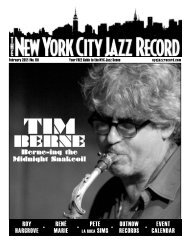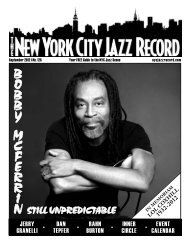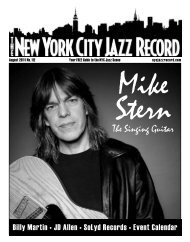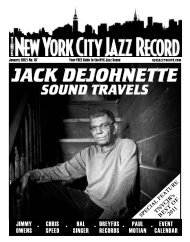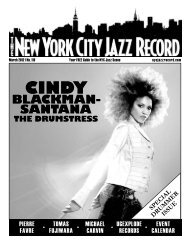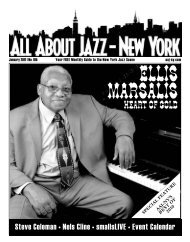Return of the Guitar Man - The New York City Jazz Record
Return of the Guitar Man - The New York City Jazz Record
Return of the Guitar Man - The New York City Jazz Record
You also want an ePaper? Increase the reach of your titles
YUMPU automatically turns print PDFs into web optimized ePapers that Google loves.
Loose Torque<br />
by Ken Waxman<br />
Loose Torque is <strong>the</strong> audio equivalent <strong>of</strong> a small press<br />
publisher that concentrates on aes<strong>the</strong>tics. Just as those<br />
firms’ limited-edition books are printed on highquality<br />
paper with covers produced by hand-operated<br />
letterpress, Loose Torque CDRs are computer-burned<br />
in batches <strong>of</strong> 100, using specialist Taiyo Yuden discs,<br />
with pr<strong>of</strong>essionally designed packaging.<br />
Loose Torque is <strong>the</strong> brainchild <strong>of</strong> veteran British<br />
bassist Nick Stephens, who describes himself as “artistproducer-runner.<br />
I play on and record <strong>the</strong> music, mix<br />
and edit it, think <strong>of</strong> titles, burn, print and pack <strong>the</strong><br />
discs and take <strong>the</strong>m to <strong>the</strong> post <strong>of</strong>fice.” Founded in<br />
2005, Loose Torque has already released 21 CDRs,<br />
ranging from archival sessions with such major UK<br />
players as alto saxophonist Dudu Pukwana and<br />
drummer John Stevens to contemporary dates that<br />
showcase Norwegian saxophonist Frode Gjerstad,<br />
British trumpeter Jon Corbett and South African<br />
drummer Louis Moholo-Moholo among o<strong>the</strong>rs. <strong>The</strong><br />
label’s literal in-house art staff is Stephens’ wife Fay,<br />
an illustrator and <strong>New</strong> Media designer, who also<br />
maintains <strong>the</strong> website.<br />
Loose Torque’s genesis resulted from a combination<br />
<strong>of</strong> serendipity and frustration. “I had a lot <strong>of</strong> tapes in<br />
my cupboard mostly from my 17-or-so years with John<br />
Stevens,” Stephens explains. “Similarly Dudu recorded<br />
everything he did and not long before he died he gave<br />
me a shoebox full <strong>of</strong> tapes.” Also on hand was a studio<br />
Antwerp 1988<br />
John Stevens’ Fast Colour<br />
LABEL SPOTLIGHT<br />
JC STYLLES is a guitarist originally from Australia,<br />
who first hit <strong>New</strong> <strong>York</strong> <strong>City</strong> in <strong>the</strong> period 1992-95<br />
before returning permanently in 2005. He specializes<br />
in <strong>the</strong> guitar/organ trio format and has performed<br />
with many leading Hammond B-3 organists. Recently<br />
signed to <strong>the</strong> Motéma Music label, Stylles currently<br />
leads a trio featuring <strong>the</strong> exciting organist Pat Bianchi.<br />
Teachers: Mostly self-taught before attending jazz<br />
camp as a teenager featuring Vic Juris, Steve Erquiaga,<br />
John Sc<strong>of</strong>ield and o<strong>the</strong>rs. Undertook master classes in<br />
<strong>the</strong> early ‘90s by Pat Martino, Tal Farlow, John<br />
Abercrombie and Barry Harris and one-on-one studies<br />
during <strong>the</strong> same period with Rodney Jones.<br />
Influences: Wes Montgomery, George Benson, Charlie<br />
Parker, Bobby Hutcherson, Jimmy Smith and o<strong>the</strong>rs.<br />
Current Projects: <strong>New</strong> CD Exhilaration & o<strong>the</strong>r states on<br />
Motéma Music and completing an instructional video<br />
on <strong>the</strong> right-hand picking technique developed by<br />
George Benson.<br />
By Day: Trying out new recipes, accompanied by a<br />
glass <strong>of</strong> red wine, while listening to Bobby Hutcherson.<br />
I knew I wanted to be a musician when... I heard<br />
Bird’s ballads from <strong>the</strong> Dial sessions at around eight<br />
years old, but really knew it when as a teenager I was<br />
a salad hand in a restaurant and had to clean out pots<br />
‘round midnight that were big enough to bath in.<br />
Calling Signals<br />
LISTEN UP!<br />
12 October 2011 | THE NEW YORK CITY JAZZ RECORD<br />
Gjerstad/Moholo/Poulsen/Stephens<br />
effort recorded in 1996 by Calling Signals, Stephens’<br />
band with Gjerstad, which didn’t interest commercial<br />
labels. But “<strong>the</strong> clincher was my Septet. I was very<br />
proud <strong>of</strong> <strong>the</strong> group, had two years worth <strong>of</strong> recordings,<br />
but couldn’t get it on record.” Meanwhile Stephens<br />
had already built a home-studio. “I was coming-up 60<br />
and beginning to feel unsure about my immortality. I<br />
wanted some way <strong>of</strong> documenting musicians and our<br />
place in <strong>the</strong> music <strong>of</strong> <strong>the</strong> time,” he remembers.<br />
Soon he discovered <strong>the</strong> advantages <strong>of</strong> Taiyo Yuden,<br />
a company in business since 1950, which patented <strong>the</strong><br />
world’s first CDR. “I wanted short runs. I’ve heard<br />
independent label owners say having 1,000 CDs leaves<br />
<strong>the</strong>m with a garage full <strong>of</strong> unsold discs. But ours is<br />
genuinely a cottage industry. Up until recently I burned<br />
<strong>the</strong> discs one at a time to order. I’ve now bought a<br />
seven-CD tower, but I still <strong>the</strong>rmal print each disc one<br />
at a time.” Ano<strong>the</strong>r long-time improviser who <strong>of</strong>ten<br />
plays with Stephens, Corbett thought up <strong>the</strong> label<br />
name: “Loose Torque suggests informal dialogue and I<br />
thought that it quite aptly described improvised music<br />
where <strong>the</strong> participants interact with each o<strong>the</strong>r.”<br />
<strong>The</strong> label’s first batch <strong>of</strong> seven releases included<br />
Fast Colour Antwerp 1988, by a Stevens-led septet never<br />
documented on record. Besides <strong>the</strong> drummer and<br />
bassist, personnel included trumpeter Harry Beckett,<br />
Pukwana and Evan Parker on saxophones, trombonist<br />
Annie Whitehead and vocalist Pinise Saul. Over <strong>the</strong><br />
years, “Fast Colour has been our best seller, but anything<br />
with <strong>The</strong> Vikings - Frode and Paal [Nilssen-Love] - or<br />
Louis [Moholo-Moholo] on it also causes some<br />
interest,” Stephens notes.<br />
“Nick and I are friends so when we do something<br />
Integration<br />
John Stevens Away<br />
Dream Band: A Charlie Parker-Wes Montgomery-<br />
Bobby Hutcherson frontline with a mid ‘60s Herbie<br />
Hancock trio.<br />
Did you know? I grew up in a commune-like<br />
environment in a predominantly aboriginal town in<br />
tropical Australia.<br />
For more information, visit jcstylles.com<br />
JC Stylles<br />
Chris Welcome<br />
From sparse chamber-jazz to spastic avant-metal,<br />
guitarist CHRIS WELCOME lends his unique voice to<br />
a variety <strong>of</strong> ensembles. His compositions combine<br />
space and pointillism with extended techniques and a<br />
loose jazz sensibility. Born in 1980 in <strong>New</strong> <strong>York</strong>,<br />
Welcome grew up around Chicago and lives in<br />
Brooklyn.<br />
Teachers: I’m lucky to have studied with two great<br />
guitar teachers, Frank Portolese and Vic Juris. I also<br />
Don’t Answer It<br />
<strong>The</strong> Schizo Quartet<br />
toge<strong>the</strong>r he’ll record it and if he and I think it’s OK,<br />
he’ll release it,” reports Gjerstad. “A CDR reflects <strong>the</strong><br />
fact that this is a small music. But it shows that it’s<br />
possible to release stuff without having a major label<br />
contract. Limited distribution doesn’t bo<strong>the</strong>r me. When<br />
I tour I bring CDs along and people buy <strong>the</strong>m. Loose<br />
Torque may be a kitchen operation, but at <strong>the</strong> end <strong>of</strong><br />
<strong>the</strong> day, <strong>the</strong> artist still makes a little money. Some<br />
companies want all rights in exchange for releasing a<br />
CD. And with downloads and streaming it’s easy to<br />
lose control. But Nick will give me as many discs as I<br />
want [to sell].”<br />
<strong>Record</strong>ing new material is part <strong>of</strong> Stephens’ desire<br />
to document under-recorded players. “<strong>Record</strong>ing<br />
sessions are like a social club, guys who know each<br />
o<strong>the</strong>r meeting in a relaxed atmosphere with no<br />
temporal or financial restrictions, apart from pub<br />
opening hours,” says Corbett. “You don’t get that from<br />
more commercial labels. Nick is very open to<br />
suggestions and you can get involved in <strong>the</strong> editing<br />
and mixing if you so wish, or leave it to his excellent ears.”<br />
As for archival discs, “<strong>the</strong> decisions over which<br />
old material to release are based on sustained quality<br />
<strong>of</strong> music and sound, potential interest and my time,”<br />
Stephens explains. Dangerous Musics In ‘91, for<br />
instance, with himself, Corbett and drummer Roger<br />
Turner was “a group that was influential at <strong>the</strong> time,<br />
but unrecorded and hardly known outside <strong>of</strong> London.”<br />
<strong>The</strong> CDR is drawn from two cassette tapes; one from a<br />
session at Turner’s flat and one “from a tape that Jon<br />
found down <strong>the</strong> back <strong>of</strong> his s<strong>of</strong>a which must have been<br />
given to him by someone after a gig.”<br />
(CONTINUED ON PAGE 41)<br />
studied harmony and <strong>the</strong>ory with Ralph Bowen and<br />
Stanley Cowell at Rutgers University.<br />
Influences: Charlie Parker, Derek Bailey, Sonny<br />
Sharrock, Anthony Braxton, Webern, Hendrix, Joe<br />
<strong>Man</strong>eri, Stockhausen, Miles, Monk, Sonny Rollins,<br />
John Cage, Black Sabbath, all my teachers.<br />
Current Projects: Chris Welcome Quartet; Mothguts,<br />
Trio Caveat; trios with Lisa Mezzacappa and Mike<br />
Pride and Kirk Knuffke and Federico Ughi; duos with<br />
Shayna Dulberger, Bonnie Kane and Mike Noordzy.<br />
By Day: Drink c<strong>of</strong>fee, write music, practice, teach<br />
lessons (in that order).<br />
I knew I wanted to be a musician when... I’ve been<br />
obsessed with music my entire life. I can’t remember a<br />
time when I didn’t want to be a musician.<br />
Dream Band: Playing with Jonathan Moritz, Shayna<br />
Dulberger and John McLellan in my quartet is pretty<br />
dreamy!<br />
Did you know? I’ve also written a lot <strong>of</strong> chamber and<br />
electroacoustic music. You can hear recordings <strong>of</strong> some<br />
<strong>of</strong> <strong>the</strong>se pieces at chriswelcome.com.<br />
For more information, visit chriswelcome.com. Welcome is<br />
at Douglass Street Music Collective Oct. 3rd and Prospect<br />
Series Oct. 8th. See Calendar.<br />
Attic Antics<br />
Lonberg-Holm/Stephens


